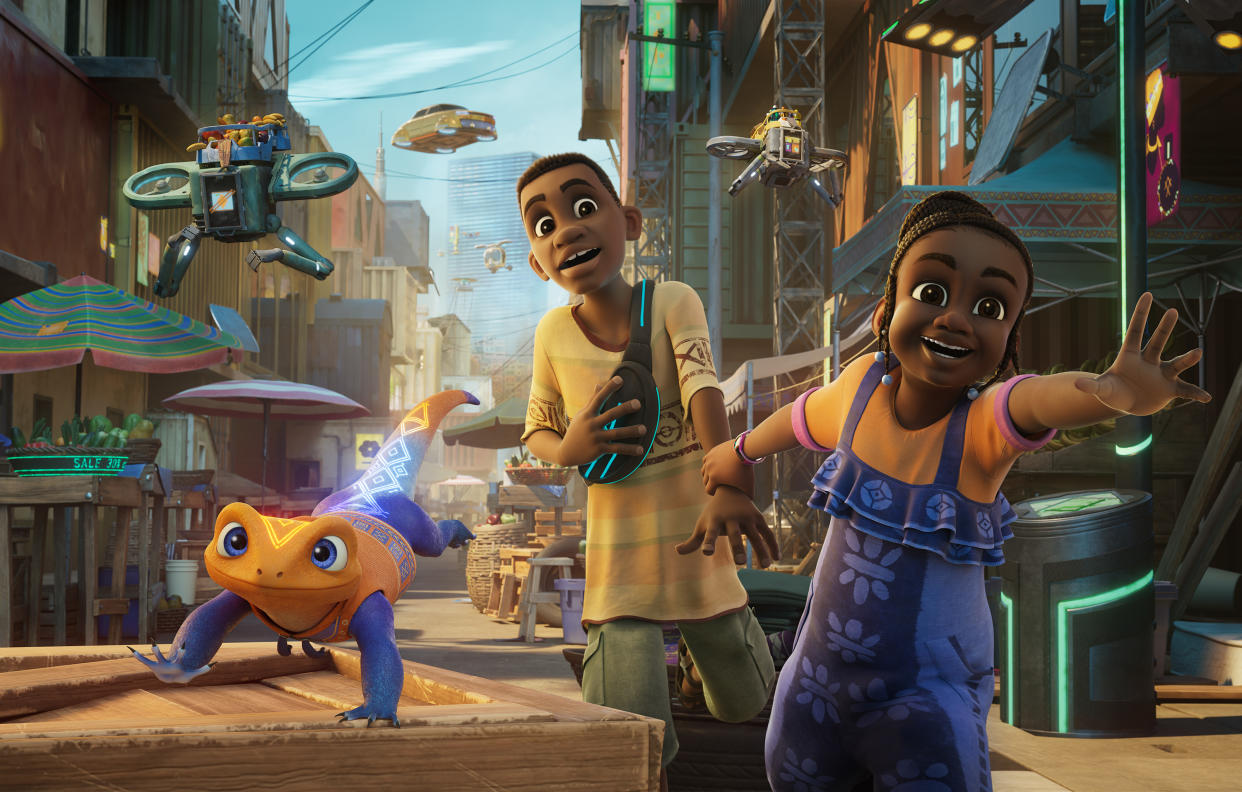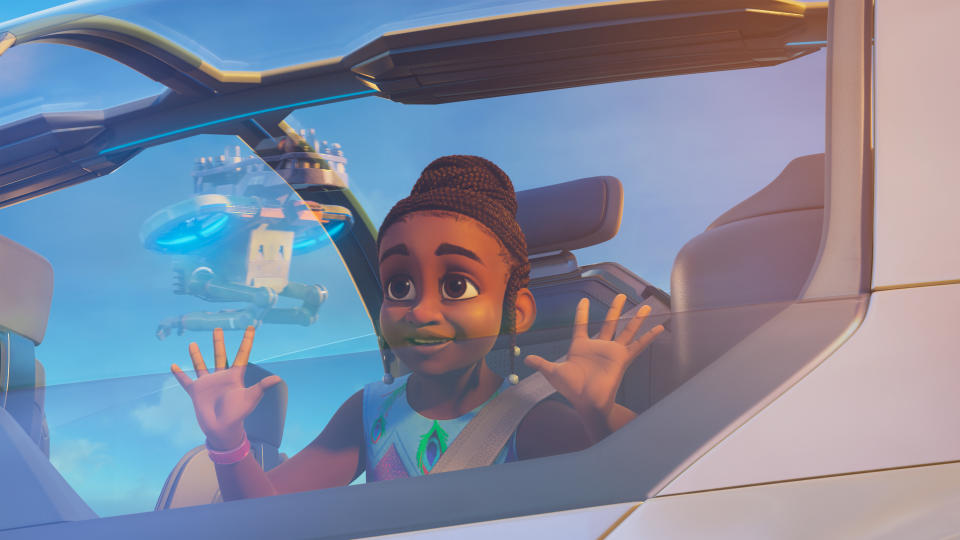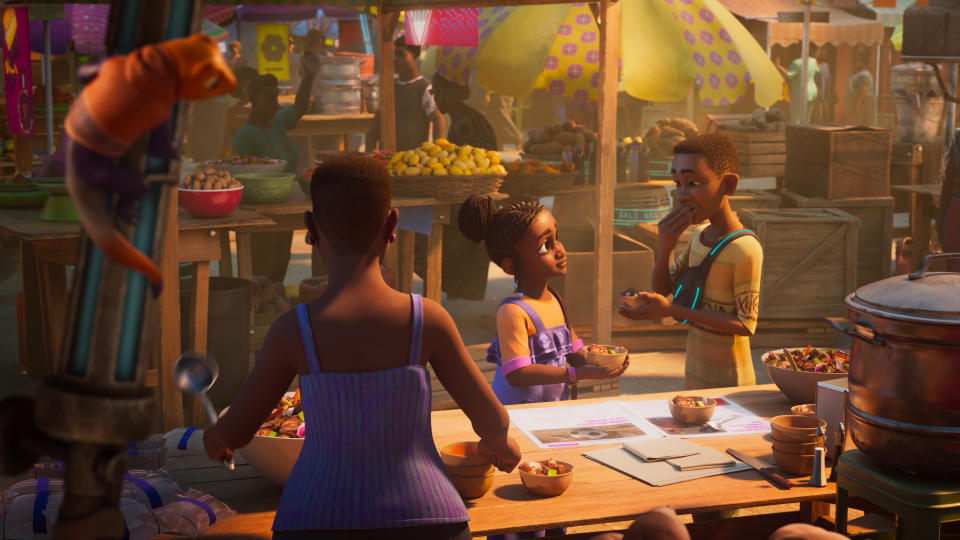The Team Behind ‘Iwájú’ Joked They Wanted to Compete with Disney — and Disney Called with an Offer

- Oops!Something went wrong.Please try again later.
“Iwájú,” Disney Animation’s sci-fi long-form series about a futuristic Lagos (currently streaming on Disney+ and coming to The Disney Channel April 22), is a far cry from such culturally diverse features as “Moana,” “Raya and the Last Dragon,” and “Encanto.” This is a Nigerian series — Disney’s first-ever outside collaboration of this kind — told from the Black team at Kugali Media, the U.K.-based Pan-African media company, voiced by Nigerian actors, and with a score from Nigerian composer Ré Olunuga.
“Iwájú” (which loosely means “the future” in Yoruba) began as a Kugali comic book anthology. Kugali co-founders Olufikayo Ziki Adeola, Hamid Ibrahim, and Tolu Olowofoyeku let it be known in an interview they had their sights set on animation and were determined to “kick Disney’s arse in Africa.” This came to the attention of Disney Animation’s chief creative officer, Jennifer Lee, who was so impressed with the boast and their material that she reached out to Kugali, and they formed a partnership. What started out as a series of shorts evolved into the long-form series.
More from IndieWire
Kugali served as the main creatives in collaboration with the Disney team: producer Christina Chen (“Encanto”), executive producers Lee and Byron Howard (Oscar-winning director of “Encanto” and “Zootopia”), screenwriter Halima Hudson, VFX supervisor Marlon West (“Moana”), and editor Fabienne Rawley (“Zootopia”). Meanwhile, Cinesite’s London and Montreal facilities handled the animation, with pre-production and storyboarding taking place at Disney Animation’s Burbank and Vancouver studios.
Adeola’s vision as creator and director was to depict Nigeria 100 years in the future, where high tech has benefited the daily lives of its citizenry. The focus, however, was on the haves and have-nots of Lagos, where Adeola grew up before emigrating to the U.K. as a teen. Ibrahim served as the series’ production designer, and Olowofoyeku was the cultural consultant.
“‘Iwájú’ was born from my personal desire to tell a story about Lagos because one of the unique things I noticed is how the geography actually supports the societal divide in a way that is very stark,” Adeola told IndieWire. “In Lagos, the wealthy people live on the island, and the working class and poor people live on the mainland, by and large. So you literally have a body of water separating rich and poor. And so I thought that was a really interesting foundation upon which to build a science-fiction story.”
The story concerns Tola (Simisola Gbadamosi), a savvy 10-year-old girl from the island, and her best friend Kole (Siji Soetan), a self-educated tech expert from the mainland. They become embroiled with a 7-foot-tall crime lord, Bude (Femi Branch), who rules the mainland and fancies himself as a sort of Robin Hood.
“The theme of inequality was the first one that became really apparent to me,” Adeola continued, “but I personally like aspirational stories because I think hope is really important to the human spirit. And I wanted to tell a story about how the world currently exists and challenge the status quo [through Tola]. Society almost beats us into submission to accept the world the way it is. And we lose that magic we had as we were children, which brings us to the theme of innocence. Because Tala, our protagonist, still has that childlike innocence and aspirational quality that gives her the impetus to fight for the world the way she is.”
The futuristic vision led to imaginative world-building from Ibrahim. The mainland was designed to house as many people as possible in huge towers, while the island was made to look like an exquisite art piece. This was a hyper-real extension of the current state of Lagos, and the tech was made to fit the needs of that world.

For example, there are flying cars with spherical wheels: “That’s because everybody drives like crazy,” Ibrahim told IndieWire. “So, if you have a spherical wheel, you can navigate the craziness much better. Now, as a direct result of that, in Lagos, we have people who would sell things to people on the road. So, in this show, if all the rich people who have most of the wealth are up in the air, the people had to innovate and create drones so you could sell to them.
“The only two elements that were not grown directly from real-life Legos are what I call the hard lights and paper screens,” Ibrahim continued. “People have found a way to tame light so it’s physical, like the weapons.” Tola also has a pet robot lizard named Otin (Weruche Opia), which is made of the same hard light material. “And because it’s light, you can technically expand it into a certain shape. So it can get bigger or smaller,” added Ibrahim. “The other element, paper screens, are cheap and they’re everywhere, but it also helps us enhance the mainland with all these colorful screens that make it beautiful in a different way.”
Collaborating with Disney Animation was a learning curve for Adeola. “Disney Animation is a director-driven studio,” Adeola said. “So the ethos is to empower the director to tell the story he wants to tell, and they brought their experience and resources to help make that story a reality. Disney Animation was genuinely interested in learning about Lagos, learning about the lifestyle. But the animation was the most fun because the scripting and storyboarding can be quite painful going over scenes hundreds of times.”

The animation boasted a mixture of African, Eastern, and Western animation styles, as well as a painterly look for select background scenes. However, Ibrahim, who was heavily involved in lighting and effects, got to work with the legendary Academy governor West, who got his start at Disney as an effects trainee on “The Lion King,” the production designer’s favorite Disney film.
“He’s been working in animation longer than I’ve been alive,” Ibrahim said. “But obviously, there’s always that weird thing where if you’re having creative differences, the best ideas tend to win. And at the end of a Zoom meeting, I’d turn off the camera and realize that I just argued with the person who created the thing that inspired me to work in animation.”
But during an intense fight in the Episode 6 finale, where there’s a clash of dueling tech, the hard light wasn’t popping with the impact they wanted. “And [Marlon] told us about this old school VFX strip that they used to do back in the 2D days, where you add a white frame,” added Ibrahim. “And he brought that in there, and it actually worked. It was that crazy thing where something is driving you crazy, and he just nailed it right away.”
Best of IndieWire
The 65 Best Sci-Fi Movies of the 21st Century, from 'Melancholia' and 'M3GAN' to 'Asteroid City'
Christopher Nolan Movies, Ranked from 'The Dark Knight' and 'Tenet' to 'Dunkirk' and 'Oppenheimer'
Where to Watch This Week's New Movies, Including 'Argylle' and 'How to Have Sex'
Sign up for Indiewire's Newsletter. For the latest news, follow us on Facebook, Twitter, and Instagram.

